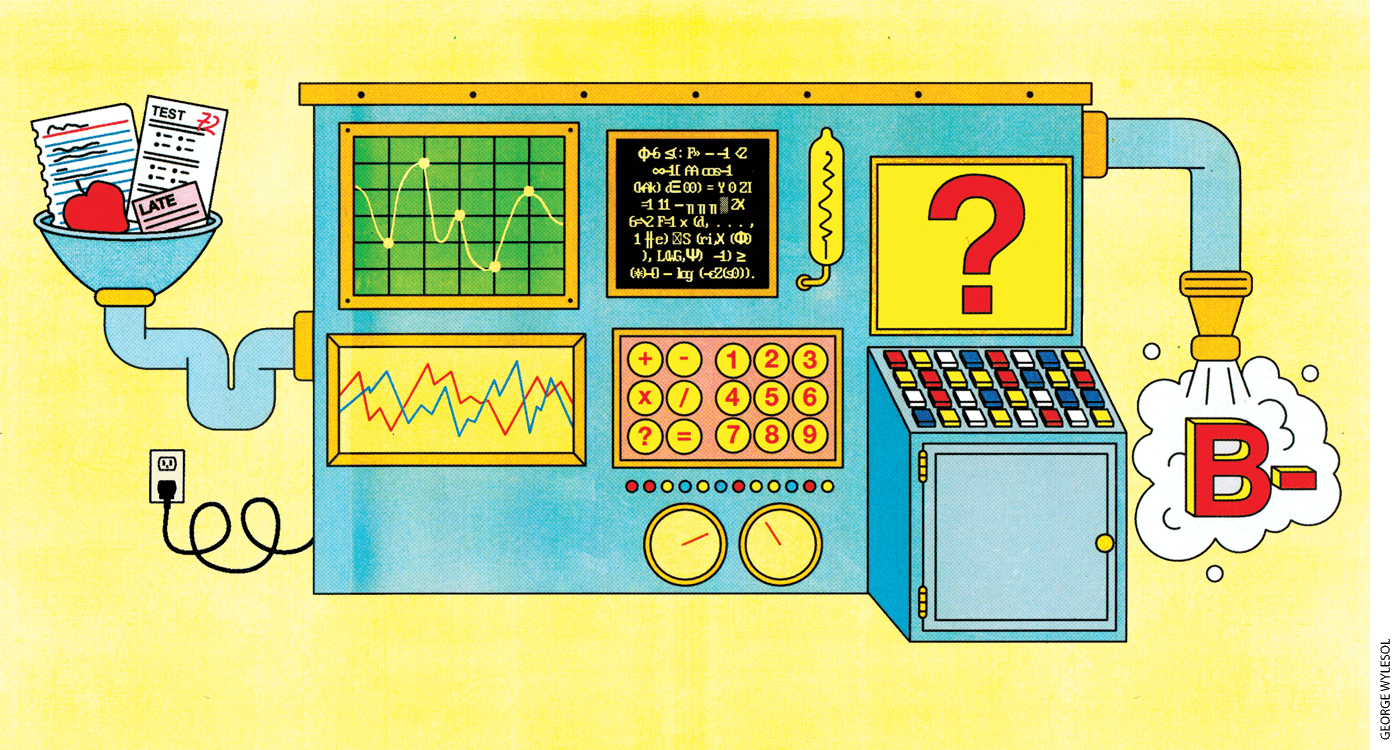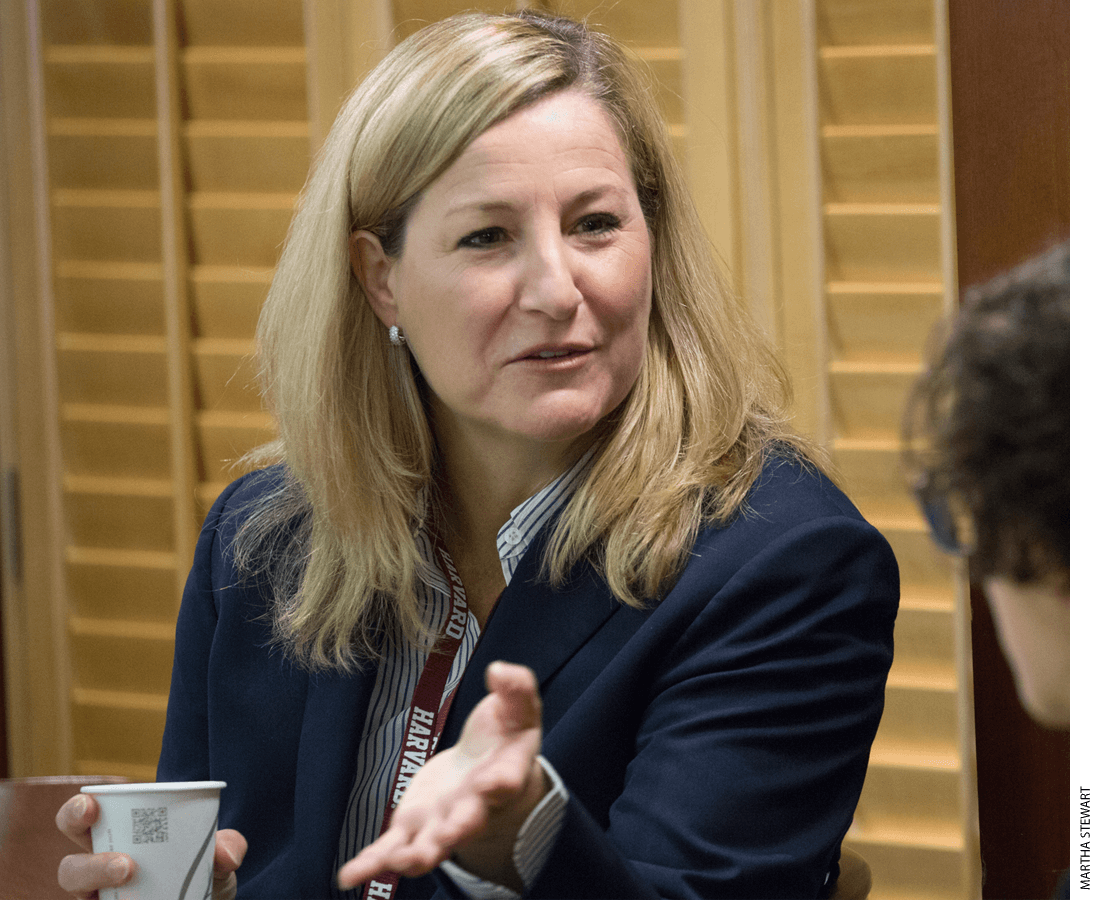
The practice of grading student work has mostly been an afterthought in teacher training and professional development. Grading remains idiosyncratic in most places—largely dependent on rubrics devised by individual teachers and usually rooted in century-old practices, even if they are calibrated using new technologies and software.
Letter-based grading became universal in U.S. public schools by the 1940s. Today, protocols for handing out grades of A–F on a 100-point scale vary from district to district and classroom to classroom. Generally, grading attempts to distill students’ performance on what education researcher Thomas R. Guskey calls a “hodgepodge” of measures—quizzes, tests, homework, conduct, participation, extra credit, and more—rather than gauging actual student learning.
The process is inconsistent at best, inequitable at worst, critics argue. Reform efforts made over the past two generations—such as the push for portfolio grading that gained traction in the 1980s—largely foundered, as they were viewed as too cumbersome to scale up to large districts and schools.
Now the consequences of the Covid-19 pandemic—remote learning and more failing students—twinned with renewed concerns over equity have many educators taking another look at grading. Several models exist, but so-called equitable grading is gaining momentum.
“Inherited grading practices have always hurt underserved students,” said Joe Feldman, a former teacher and author of Grading for Equity: What It Is, Why It Matters, and How It Can Transform Schools and Classrooms. “As schools reopen, there is a desire for normalcy, but we shouldn’t rubber-band back” to outdated practices, Feldman argues.
Equitable grading involves eliminating the 100-point grade scale and not penalizing students for late work and missed assignments if they can demonstrate subject mastery and even if they must retake tests or redo other assessments along the way.
Feldman says these assessment practices can help address stubborn achievement gaps and streamline the grading hodgepodge. But moves toward equitable grading seem to be rolling out in a patchwork fashion, and not without pushback and confusion.
“Because of the way it was implemented, nothing has been standard about it at all. Much has been left open to interpretation,” said Samuel Hwang, a junior at Ed W. Clark High School in Las Vegas, a school that has introduced equitable grading. “In a lot of ways, things have gotten worse.”
The 360,000-student Clark County, Nevada, district, which encompasses Las Vegas, began implementing the policy in the 2021–22 school year, on the heels of the pandemic learning disruptions. “They rushed out the new policy just when we got back to school,” said Hwang, who serves as a peer tutor. Many students, he said, are habitually late on assignments. “If your expectations are lower in terms of behavior and grading, that’s probably what you’re going to get.”

Equitable Grading
Feldman’s plan in Grading for Equity is a recent iteration of so-called mastery-based or standards-based assessment. With this approach, teachers base grades on a student’s end-of-course command of material, without consideration of attendant factors such as homework, extra credit, or “soft-skill” behaviors such as punctuality, attendance, handing in assignments on time, and class participation. Learners are afforded extra time and can retake tests or other assessments to demonstrate mastery or raise a grade.
“The grade is only reflective of content mastery,” said Feldman. “People mistakenly assume that grading for equity lowers standards or rigor, but it increases them. You can’t get an A jumping through hoops, so it reduces grade inflation, makes it more rigorous. There’s no more of that haggling (‘Can I get extra credit for bringing cupcakes to the end-of-year party?’). There’s no more bartering and bargaining to get points. Students become less consumed with point accumulation. We can now talk about their understanding.”
Feldman essentially frames mastery-based grading as a way of correcting historical imbalances and eliminating biases in traditional grading that he says have posed barriers to success for students of color and those from lower-income families. In his view, grading should no longer reflect factors that students may not have control over, such as whether their after-school life is conducive to finishing homework.

After getting a master’s in teaching and curriculum from Harvard University’s Graduate School of Education in 1993, Feldman served for three years as a teacher and for another 17 years in a variety of administrative jobs at four public school districts around the country. He spent just under two years as a vice president at a nonprofit focused on health education before starting Crescendo Education Group in 2013, according to his LinkedIn page.
The group is a paid consultant to schools and districts of varying sizes. In one recent contract, Crescendo was paid $114,300 to introduce 60 teachers and 30 administrators in California’s Santa Clara Unified District to grading for equity by providing coaching, support, and webinars during the 2021–2022 school year.
Feldman says he has seen firsthand the “nagging discomfort” many teachers feel toward the existing grading system, which uses points to reward students for behaviors. While some of those behaviors, such as doing homework, may improve learning, they are not “point-worthy” in and of themselves, he notes.
Stressors ease once grading is motivational rather than punitive, he says, arguing for a “coherent” 0–4 grading scale to replace the 100-point scale that remains the standard in K–12 classrooms. The latter essentially measures 60 gradations of failure, Feldman points out, and that “may not be the message we want to send to students.”
Variations of this simplified scale are widely used in standards-based grading, with some schools choosing a 1–5 or 1–4 range. The points reflect levels of skill mastery, with the lowest numbers indicating little or no understanding on the part of the student and the highest representing advanced understanding. Sometimes these figures are still translated into letter grades, but the grades are based on the four or five levels rather than a scale of 100 points.
Critics of grading for equity say there is not enough empirical data or experience to suggest that the purported successes of the approach could work at scale. In many districts that have adopted equitable grading, the process is too new—and still too inconsistent—to yield reliable research data. The complications of the pandemic also thwarted the collection of empirical data, and many educators remain unconvinced of the program’s merit.
But Feldman says his book is replete with research citations, and he produced a 2018 report, School Grading Policies Are Failing Children: A Call to Action for Equitable Grading, with data from external evaluators culled from a survey of grading in two districts before and after they adopted equitable grading practices. The first district, comprising four suburban or rural high schools, surveyed 3,700 grades issued by 24 teachers. The second was an urban district with two middle schools and one high school where 10,000 grades issued by 37 teachers were charted. In both cases the number of Ds and Fs declined, as did the number of As. The report’s data also show a narrowing of achievement gaps between white and nonwhite students and between students of varying socioeconomic backgrounds.
Feldman’s report also provides an analysis of grading from 12 secondary schools that says equitable grading by more than 60 teachers produced grades that more closely correlated with students’ scores on external standardized exams.
Pragmatic and Pedagogic Concerns
Grading for equity can involve more work for teachers, since students can progress at their individual paces and take reassessments. The teachers union in San Diego, anticipating an increased workload, filed a grievance in 2021 after that district announced plans to implement equitable grading.
Teachers at the 2,500-student Wakefield High School in Arlington, Virginia, questioned efforts last year to bring Feldman’s regimen to their district, saying the plan would lead to a decline in expectations, rigor, and accountability. In a letter to the county superintendent and district school board, they argued that grading for equity could hurt the very students it purports to help—those who may not have the advantage of academic support outside of school and who could fall behind if deadlines are relaxed.
The teachers said in the letter that the experience of remote learning during the Covid shutdowns illustrated that more students ignore homework assignments if they aren’t being graded on them. They also contended that there are skills that are more important than content mastery for students to learn, such as “the habits of mind (acquiring and synthesizing information) and work habits (timely attendance, work completion, positive participation in group activities) [that] make for successful careers.”
Other teachers have raised concerns that flexible deadlines would create pragmatic as well as pedagogic problems because earlier work is a building block for what comes later and because it would be difficult for teachers to have students on different learning trajectories.
Jody Stallings, a middle school English teacher and head of the 1,000-member Charleston Teacher Alliance in South Carolina, notes that it is imperative that his students do homework. Reading assignments must be done before class discussion. “It’s all about accountability,” he said.
He and others have questioned whether getting rid of Ds and Fs actually promotes mastery or the “reforms” just make it easier to pass. And some teachers say that the program’s reliance on “intrinsic motivation” to promote learning ignores the realities
of teaching adolescents.
In an essay in the Moultrie News of Mount Pleasant, South Carolina, Stallings said grading for equity looked like a “race to the bottom.”
“Lots of people have pushed for changes in grading policy. Feldman’s shtick is to inject a lucrative dose of race and class into the mix,” he wrote. At least one other commentator latched onto the issue to bash “woke-ism” in education.

A California District Embraces Grading for Equity
Proponents of equitable grading say that shoehorning learning into strict blocks of time is a leftover from the 19th- and 20th-century factory model that is best left behind. “It’s just this false concept that learning is a race. In the professional world you get to retake tests all the time,” said Feldman.
“Why wouldn’t we give students hope that they can pass the class?” asked Jeffrey Tooker, deputy superintendent for education of the Placer Union High School district in California. “The football team could lose its first two games but still win the championship. It’s about growth, and each game is a formative assessment.”
Tooker’s district is 30 miles east of Sacramento and enrolls about 4,000 students at four high schools. Situated in the foothills of the Sierra Nevada mountains, Placer Union is mostly suburban and middle-class, but nearly a third of students do qualify for free and reduced-price lunches.
In 2018, with Feldman’s guidance, the district started shifting to equitable grading, beginning with training for teachers who volunteered as part of a “pioneer group.”
“We realized that everything in education has changed, but the one thing that hasn’t changed was grading practices. A lot of grades weren’t an accurate measure of the true learning that was going on in class,” Tooker said, using the example of a student getting extra credit because her parents went to back-to-school night. “That’s not accurate or equitable.”
The new system at Placer Union eliminates points for extra credit and places more weight on end-of-term assessments, which can assume a variety of formats, from tests to projects or presentations. Students can retake assessments until they show mastery of the subject, even if it means going beyond the semester into so-called intervention periods. Grades no longer reflect punctuality or behavior.
Allysa Trimble, a senior at the district’s Foresthill High School, said the extra time “saved” her after she got an incomplete for an online world history class last year. She used the in-person intervention period to make up the work and ultimately get a B-minus.
“I don’t know if I would have been on track to graduate before,” said Trimble, who graduated in May 2022.
Trimble said she always struggled in school and had trouble focusing, and the extra time afforded by equitable grading was a gamechanger. “I understand the need to meet deadlines in the real world,” she said, “but these grades are what allow students to move on to college or the real world. . . They shouldn’t be stopping a lot of good people being able to do great things.”
Ryan Jacobson teaches English at the school. “Equitable grading really supports building relationships. There are revisions and feedback. You have conversations, which is an opportunity to develop those soft skills. The students trust you more. They own their own work,” Jacobson said.
Jacobson said he has found that many students who have traditionally done well in school are skeptical of the shift in grading. Others embrace it, and some “see it as a way to procrastinate.’’
Equitable grading has not involved more work on his part, Jacobon said. In fact, he said it eliminates counting extraneous points and largely obviates the need to review students’ Individualized Education Plans, since he is more in tune with their needs and progress.
The district still uses letter grades, but they are based on a 1–4 rubric, not a 100-point scale. Trimble said the streamlined scale “makes it very obvious what is going on and what you need to clean up. It’s more transparent. It tells you where you’re going wrong.”
Tooker said equitable grading has made a positive impact. “Our teachers who committed to this saw a reduction in Ds and Fs and a narrowing of achievement gaps for students of color,” he said, asserting that the shift also reduced the number of As in some classes, thus tamping down grade inflation.
The reduction in Ds and Fs is particularly important when it comes to admission to California’s public university system, and that’s one reason districts in that state began adopting equitable grading—and dropping “sub-C” grades—in the throes of the pandemic. (Districts elsewhere, such as Minneapolis, also eschewed failing grades during the pandemic, switching to a credit/no credit system to protect GPAs, as many students struggled with remote learning.)
In Los Angeles, as elsewhere, the pandemic-related closures took their toll on student learning. In fall 2020, so many students were at risk of failing that the L.A. Unified School District gave them extra time over the winter break to boost their grades; almost 15,000 grades went up, according to the Los Angeles Times.
But grades in the district, the largest in California, continued to decline. A Times analysis in late 2021 found the plummeting grades led to a widening of racial and ethnic achievement gaps. The newspaper also reported that far fewer L.A. Unified students were meeting the eligibility requirements for admission to the University of California and California State University systems. Before the pandemic, about 58 percent of students completed the requisite “A-G” college-prep courses with a grade of C or better, while in the class of 2022 only 46 percent were on pace to do so. A gap of 17 percentage points or more separated Black and Latino students from white and Asian students.
The Times analysis appeared on the heels of new school-district guidelines that embraced principles of equitable grading. Teachers were directed to grade students based on their mastery of course material, to give them a chance to retake tests, and not to count factors such as homework completion. The San Diego Unified District issued similar directives.
Going Forward
At its heart, the debate over grading centers on whether grading accurately measures a student’s knowledge or mastery or is, in fact, a motivational tool. “Mastery is fundamental, and when you start turning over the rocks in looking at grading practices and policy, you see how inequitable the system is on a fundamental level,” said Susan Patrick, president and CEO of the Aurora Institute and co-founder of CompetencyWorks, an advocacy and research group.

In the United States, grading systems often feature curves and cutoffs and rankings, designed to measure achievement within the constraints of artificial time blocks rather than real-time learning, noted Patrick. The system was designed to sort students rather than “getting all kids to success,” she said.
It’s an open question whether equitable grading can scale up to larger schools and districts in the long term. Foresthill High School, where Jacobson teaches, has fewer than 200 students, and getting teachers on board in a district of 4,000 students, like Placer Union, is less of a logistical lift than it might be in other districts.
In Los Angeles, for instance, the changes implemented during the pandemic have not yet become policy in the district, which enrolls 640,000 students. Spokeswoman Shannon Haber said more than 4,000 educators have participated in a series of workshops on equitable grading since 2016, and training is continuing. But the protocols are not yet required. The school board has created a task force to consider further recommendations on the issue, she said in a written statement. The district in Arlington County, Virginia, with more than 28,000 students enrolled in 41 schools, is taking a step back from grading for equity to assess concerns—like those from the Wakefield High School teachers—that arose after the initial rollout last year.
The district will review feedback over the next academic year and allow staff to “try those practices from the ground up rather than the top down,” said Sarah Putnam, director of curriculum and instruction for the Arlington schools. Putnam said it was likely that tenets of equitable grading would be introduced incrementally so that staff would be comfortable with the changes.
That was the case at Placer Union, where the process was a “slow evolution with teachers, [and] there are varying degrees of equitable grading on each campus,” said Danise Hitchcock, the principal of Foresthill High School, who was among the first group of educators in the district who trained with Feldman.
The training “opened our eyes to the fact that grading practices that we had around for 100 years were not accurate and equitable,” she said. “From teachers’ perspectives, there’s some growing pains.”
As with most things in education, change takes time and can be stymied by bureaucratic hurdles. The individualized nature of equitable grading can run afoul of computerized grading programs, for instance. Those programs, used by virtually all schools, reinforce the practice of point counting rather than measuring actual learning, proponents of equitable grading say.
Change to something as fundamental as grading is difficult in a system as diffuse and diverse as K–12 in the United States, where there are more than 13,000 school districts and where every state sets its own curriculum and learning standards.
And grading is a fraught topic for many teachers, who view it as an effective tool for classroom management and one of the last areas where they have autonomy in systems laden with mandates and requirements. Many educators and parents are unconvinced that traditional grading systems need wholesale reform.
Feldman’s equity model will likely continue to get pushback. There are other models, however, that seek to measure mastery while accounting for behavioral factors. Guskey, a senior research scholar at the University of Louisville and professor emeritus at the University of Kentucky, has spent a fair amount of time studying grading here and abroad.
Just as a doctor couldn’t adequately express the state of a patient’s health with a single number—one that, say, synthesized diverse measures such as blood pressure, weight, and cholesterol levels—so too are “hodgepodge” academic grades insufficient, Guskey argues. He advocates for grades that, at a minimum, would separately measure the “Three Ps”: product (mastery), process (behaviors such as homework and class participation), and progress (improvement).
“This changes the whole nature of how we report on students and also adds to increased equity,” said Guskey, who noted that college-admissions officers are used to seeing these more nuanced grades on the transcripts of students from abroad.
Patrick, from the Aurora Institute, agrees. “Other countries, like Canada, do a better job of measuring individual mastery. We rely on standardized testing because we haven’t built in accountability in grading practices,” she said, likening those tests to an autopsy rather than a real-time measure of learning. “The grading piece feels like a technical element, but it is a linchpin holding in place an old system.”
Patricia Alex is a freelance writer and former education reporter and editor at The Record newspaper in northern New Jersey.
This article appeared in the Fall 2022 issue of Education Next. Suggested citation format:
Alex, P. (2022). Time to Pull the Plug on Traditional Grading? Supporters of mastery-based grading say it could promote equity. Education Next, 22(4), 38-43.


